PolyUnity, an Exercise in Bad Faith— Why You Should Never Give Your Momentum Away
I debated whether or not to release this article, as there are many nice people who work at PolyUnity. These are people I like, and I do not wish to hurt their chances at success despite them working for a company that I do not like. That being said, I think that there is a really important lesson to be learned from this situation, and I wish to communicate it to others who may be interested. To those who work at PolyUnity, I am very sorry if this affects your employment.
I am a prior employee of PolyUnity Tech Inc. That is public information. I was the third employee at the company.
I do not like PolyUnity anymore[1]. This is not necessarily public information, but it is my opinion.
I am held under NDA, an agreement I signed with PolyUnity Tech Inc. However I am allowed to speak of public information. The substance of the material in which I will speak of today is all public information or strictly personal information (about me, and only myself). Within the agreement, in order to disclose information, I must prove that the information is publicly available, so I will do so here. You may surmise that this is the smallest extent to which I can speak about the company, and that there are many more details about which I am not at liberty to speak about.
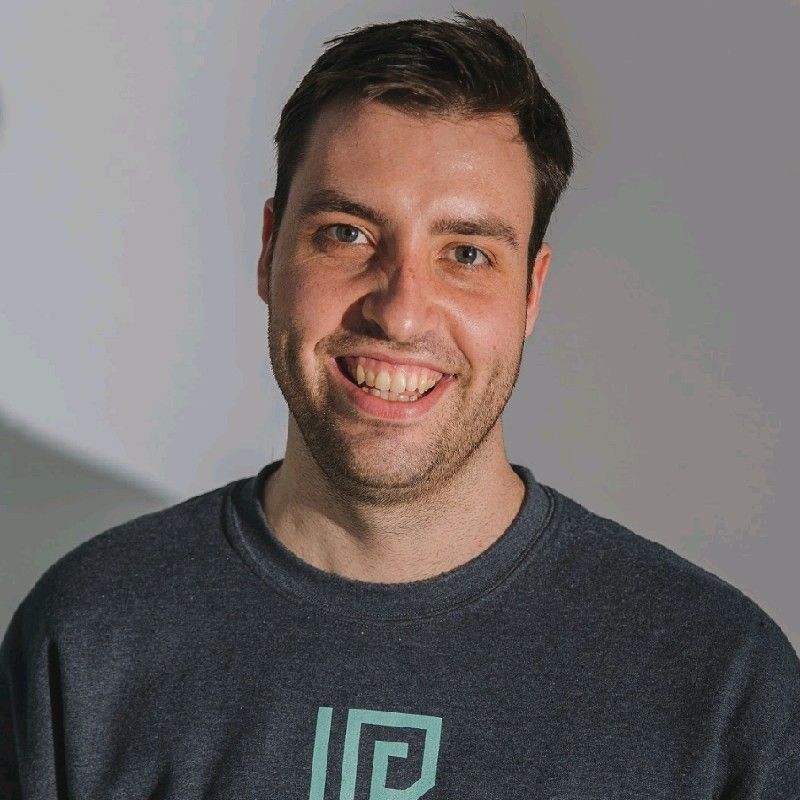
The three founders of the company are doctors. They know their craft well. Please note, however, that when I say “their craft”, I am only referring to their respective medical fields.
There was a point in time where I would have considered the “Founders” of PolyUnity: Michael Bartellas, Travis Pickett, and Stephen Ryan my friends. They were people who I “worked for” previously, at MUN Med 3D, a university organization where we made 3D printable medical simulations. I really enjoyed the work, and I believe they started something immensely valuable when they began the organization. It was work I was good at and really enjoyed, which led me down the path of focusing on 3D printing for medical purposes.
I do not consider them my friends anymore, nor do I like who they are. However, my opinion on them is much better than that of those who later became associated with PolyUnity.
Why I Came to PolyUnity ¶
I was one of the co-founders of a university group called MUN ProtoMED, which I built with the help of two of my good friends. MUN ProtoMED primarily focused on getting university students involved with making biomedical simulations. We were wildly successful in terms of new university organizations, growing to over 20 regular student members at one point in time. This is significant, because we were hardly operating for more than a year.
I gave regular tutorials to students on how to make biomedical simulations, which was one of my favourite points in my life[2]. In many ways, I felt like I was building a company from scratch, because I essentially was.
I felt like I had a winning formula. I was introducing 3D printing, biomedical design, teaching Fusion 360 to a bunch of students, it was lovely. I was beginning to look to see if I could find a commercialization path for anyone in the team who wanted to develop anything significant, and I was seriously thinking of starting my own company to do so. I had enough people interested, and made a lot of great connections to those who wanted to see us succeed. I had developed momentum.
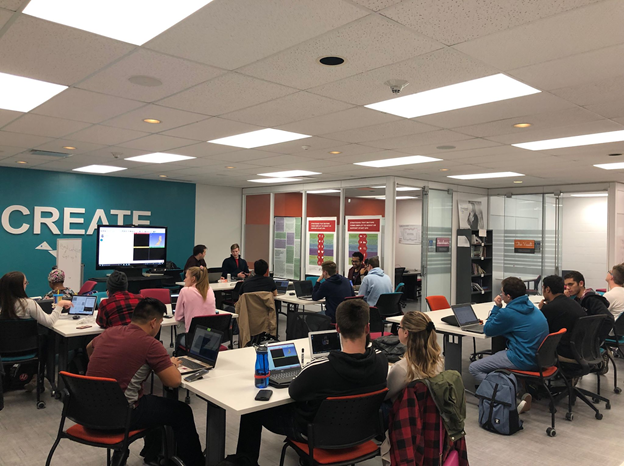
MUN ProtoMED was bringing a lot of talented students into the field. I met a lot of really great people who were incredibly adept in these fields (many of these people later joined PolyUnity[3]).
At one point, we were looking for funding to be able to purchase 3D printers and material. As a result, we (MUN ProtoMED) participated in a meeting with a government organization. We were promptly told the following (paraphrasing): “We love what you are doing, but unfortunately we can only fund companies.”
Having known the three founders of PolyUnity, I knew that they were operating in a similar field. I directed their attention towards PolyUnity, which shortly led to me becoming one of their employees. The third employee, after a computer engineering major and a business/computer science major. Things were super early, however I was confident that I would be able to play a significant role towards success- I wanted to bring my winning formula, my momentum to PolyUnity. This was my goal.
My Time at PolyUnity ¶
When I first joined, PolyUnity’s address was 22 Brownrigg Pl, a residential address[4] owned by Michael Bartellas’ father[5]. This is pretty normal at the early stages of a company, but it often suggests something about the state of the company. Far more companies fail at this stage than succeed.
PolyUnity was primarily focused (publicly, that is) on Medical Simulations when they first started[6]. Subject matter which I was regularly teaching students how to develop via MUN ProtoMED.
Around the time that the pandemic hit, PolyUnity became known as the “PPE” company. This is because PolyUnity shifted focus towards 3D printed face shields[7] in order to supply Eastern Health with much-needed face-shields.
There is much that I want to take credit for, but as I have explained, I can only disclose what is public information. Taking that into consideration, these are my designs. I designed the face shield product that brought the huge boost of success to PolyUnity.
With my employment at PolyUnity, I brought along my focus on the potential for small-to-medium volume manufacturing with 3D printers, along with specific expertise of the available equipment on the market to be able to successfully pull off manufacturing of end products. I was the first employee which had a mechanical background, and particularly a design-for-3D-printing background, having done it for years prior[8]. On top of it all, I had a network of extremely valuable connections already developed.
Here is a comment posted on Facebook.com where Michael Bartellas, the CEO of the company, gave me credit for the design of the face shield, along with “several other critical pieces”:
Simon Hawkenson has been an incredible part of this project. He made the design, along with several other critical pieces. We cannot say enough good things about him!! - Michael Bartellas
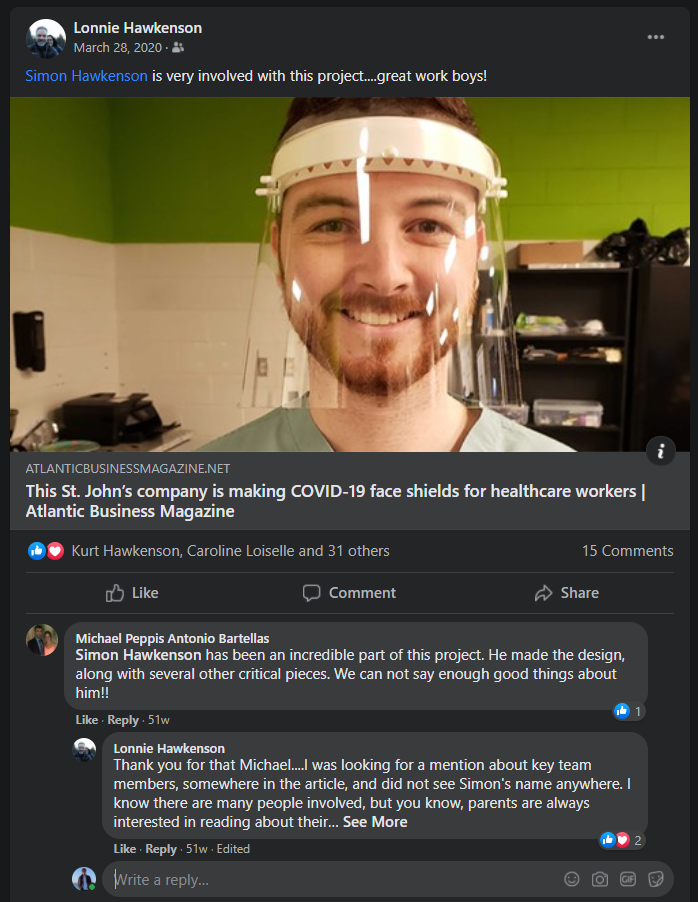
Thankfully, I can show material which I published and presented publicly for my work term deliverables. Here you can see a picture of my desk with a 3D printer, and an early prototype of the face-shield[9].
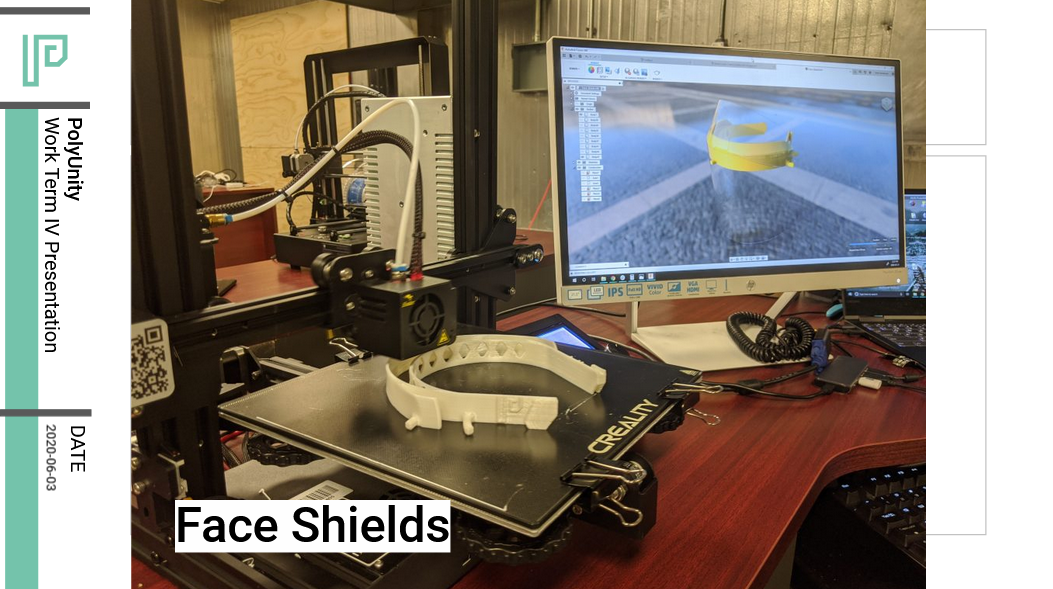
This was a tremendous amount of work, as is best stated by company COO (at the time), Travis Pickett.
“From design to prototyping to Health Canada approval to quality assurance testing with Eastern Health and finally manufacturing, we had a turnaround time of three weeks to the day. We are hoping to continue to build this effort and produce approximately 4,000 a week in the immediate future.” - Travis Pickett[10].
This was a very intense period of my life, there were many nights where I got very little sleep. I put a tremendous amount of effort into whatever I was developing at that point in time, and it took a serious toll on me. That being said, I recall feeling optimistic about my effort.
There were many people involved in the process of getting the product prepared for manufacturing. However, what I hope to establish here, is that I was a critical member to the early success of the company.
More importantly, the timing of my arrival, along with the background, network, and experience (previously developed via MUN ProtoMED) which I brought to the company, correlates with the rapid success of PolyUnity.
Why I Stayed ¶
I was working for PolyUnity on a work term. Work terms only last so long, eventually you have to return to school.
Luckily, at the time, the MUN Coop Office was offering a year long work term option, an option that was elected in order to see PolyUnity continue to grow. I decided to delay my graduation for PolyUnity, a company that wasn’t mine in any way, shape or form. This was a sacrifice made in trust, trust in the people who I considered my friends.
This wasn’t enough, however. Part of trust means that the people who you trust will reward you for your efforts. Particularly if those people you trust own the near-entirety of what you poured your heart and soul into. As such, I was compelled to remain within the company.
How was I compelled? Part of it was by stock options, where I briefly owned stock in the company (roughly 1.1%). A very small amount, even when considering the public information about my contributions to the company, never-mind the information which I cannot disclose.
Remember, the company was based out of a residential address owned by the father of the CEO of the company, with three employees. Companies at this stage rarely survive, and I had given them a design (amongst other non-discloseable things) that was a major contributor to their success. From the public’s eye, this was their sole product which had any large-scale success.
Most companies that need specific talent at the extremely early days of a companies success will choose to compensate their employees with significant stock ownership, as other forms of compensation (significant salaries, etc) are usually off the table and too difficult to honour. This is what is standard.
I cannot speak for others, but this was not what happened to me. Instead, I got a different, non-standard offer which I thought was acceptable. And as such, I stayed.
Considering I no longer work for them, you may surmise that something went wrong.
Nearing the End ¶
PolyUnity continued to grow, developing products and making partnerships. I had a few key projects and responsibilities, amongst them were:
- 3D printer research, particularly focused on increasing productivity and reliability.
- Computer vision project to identify print failures using a webcam.
- “[Ensured] that the software integrate[d] with [PolyUnity’s] hardware/3D printers.”
However, my title was “Mechanical Lead”. I also “lead” a team. We generally focused on the research side of the engineering.
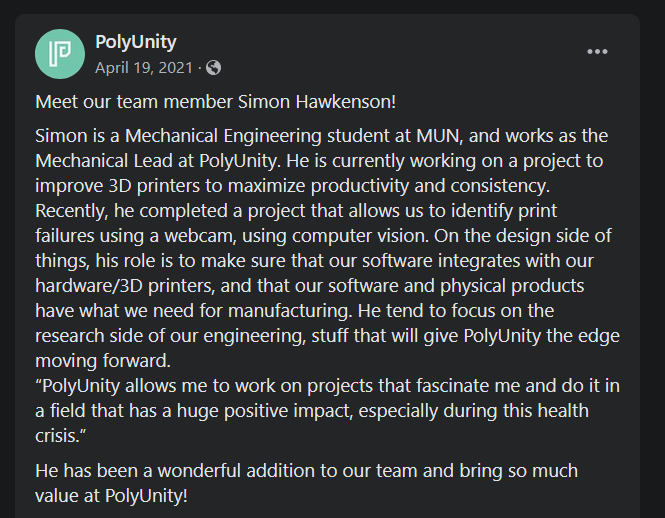
Two significant things happened near the end of my time with PolyUnity. One that I cannot disclose, the other was that I returned to school to finish my degree, after having delayed it for nearly a year to help PolyUnity get off the ground. I had already made my sacrifice for the company, and now it was time for me to return to school.
A Dropped Call from Telus ¶
Completing a degree, particularly an engineering degree, while remaining employed is something that usually needs to be planned in advance, and more importantly, agreed to by the employer. Mechanical Engineering is a program which has a significant workload, and is full time.
I completed a semester while remaining as a PolyUnity employee. From this information, there may be a few key assumptions that can be made. Usually along the lines of advanced arrangements, agreements, and approvals.
On my second semester, I was let go from the company. This was nearly a year ago, in June. I was let go while completing school. AFTER my sacrifice had already been made.
On my Service Canada record of employment document, there is a name that wasn’t publicly associated with PolyUnity. Jacqueline Lee.
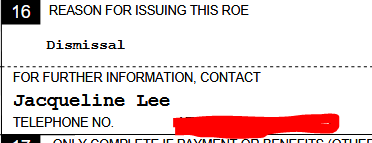
5 months ago (September), it was publicly announced that Mark Gillingham and Jacqueline Lee were joining PolyUnity as President and COO, respectively.
At the time of my dismissal, both Mark Gillingham and Jacqueline Lee were officially working for Skyhawk Telematics, a company owned by Telus. By September, both Mark Gillingham and Jaqueline Lee officially “left” SkyHawk, in order to join PolyUnity.
These two details do not add up. What is a Telus’ employee’s name doing on my employment record when they filed for my termination? I cannot say.
What I can say, is that I really, really do not like these people.
Since that point in time in June, some of the earliest employees of the company have left to move on to greener pastures[11]. Myself included. And some of those who remain, are also co-founders of their own technology company. These are often publicly-visible markers of a bad administration.
Further publicly-visible markers of a bad administration:
- PolyUnity’s website is built off of WebFlow[12], a web service that allows you to make your own websites. Considering PolyUnity markets itself in part as a software company, the companies’ age, and its relative success, it is embarrassing that they did not develop their own site. To be clear, I do not wish to disparage whoever designed the site in WebFlow. It looks much better than the previous one. The embarrassment is with the company and its leadership.
- PolyUnity appears to have a disjointed focus, marketing many different things on their website, instead of a single focal product to sell. Their attention appears to be scattered. This likely makes their potential clients confused, and less likely to work with them.
Given this mix of strictly personal and public information, paint the picture as you will.
Why You Should Never Give Your Momentum Away ¶
Everything is momentum. Success comes from momentum.
I had developed a tremendous amount of momentum prior to joining PolyUnity, and after leaving PolyUnity, I now have to rebuild it.
This is part of the reason why I built this site. I am re-building momentum. However, this time, I am much more experienced with a wide variety of fields within which I am passionate, including software development. This site was developed by me, using a few choice Node.js frameworks. I am working my way towards something greater.
Those who wish to work with you in good faith will not choose to sap your momentum. Instead, they will want to see you build it, and see the success benefit everyone who is in close proximity, including themselves. You should never choose to give your momentum away. Rather, you should choose to help build other people’s momentum in parallel to yours, a formula that benefits everyone. Pick who you work with wisely, and trust yourself when something feels wrong.
There was a lot that I wanted to talk about. I could talk about my experience of feeling betrayed, I could talk about the consequences of working yourself to the point of burnout- a sign that you aren’t trusting yourself when something feels wrong. I can talk about good leadership vs bad leadership. But most of all, I just want people to pay attention to themselves, their emotions, and their instincts. I want you to understand that you may be giving your valuable momentum away.
Listen to yourself. Trust yourself. You already know who you can trust, and who you can’t.
Those who know me, know that I loved the company, and worked hard to see it reach success. My opinion has changed quite a lot since then. ↩︎
Hindsight about my decisions in the year 2020 is 2020. Regardless, I wish I would have prioritized this university group, since there was a lot of great things going on, and my life took a turn for the worse after choosing to prioritize PolyUnity. ↩︎
4 employees, past and present, came to PolyUnity in part due to their association with ProtoMED. Some of which I believe to be incredibly talented, perhaps amongst the most talented in the entirety of Canada. ↩︎
PolyUnity’s old address can be still seen here: https://local.infobel.ca/CA103401264-7097636523/polyunity_tech-saint_john_s.html ↩︎
A document showing Elias Bartellas (Michael Bartellas’ father) was granted a building permit for his property back in 2007. https://www.stjohns.ca/sites/default/files/files/minutes/Regular Meeting October 09 2007.pdf ↩︎
The internet is a wealth of public information, past and present. Here is a copy of their website archived by the Wayback machine from back in 2019: https://web.archive.org/web/20190701204853/https://polyunity.com/ ↩︎
This generated a ton of good press for PolyUnity. For example, see CBC article: https://www.cbc.ca/news/canada/newfoundland-labrador/ppe-taskforce-nl-polyunity-1.5532678 ↩︎
Visible from LinkedIn, and internet archives of PolyUnity’s website. ↩︎
Presented publicly. The Coop Office at Memorial University of Newfoundland never signed an NDA, an option which is available (but was not taken). ↩︎
Company COO (At the time), speaking (publicly) on the turnaround of prototype to product. https://gazette.mun.ca/public-engagement/made-right-here-2/ ↩︎
Visible from LinkedIn. 2 of the earliest team members are no longer with the company. ↩︎
If you inspect the source of PolyUnity’s current website, you’ll see many links to the service WebFlow. ↩︎